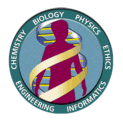|
Basic
Information
 FAQs FAQs
 Glossary Glossary
 Acronyms Acronyms
 Links Links
 Genetics 101 Genetics 101
 Publications Publications
 Meetings Calendar Meetings Calendar
 Media Guide Media Guide
About
the Project
 What is it? What is it?
 Goals Goals
 Landmark Papers Landmark Papers
 Sequence Databases Sequence Databases
 Timeline Timeline
 History History
 Ethical Issues Ethical Issues
 Benefits Benefits
 Genetics 101 Genetics 101
 FAQs FAQs
Medicine
&
the New Genetics
 Home Home
 Gene
Testing Gene
Testing
 Gene
Therapy Gene
Therapy
 Pharmacogenomics Pharmacogenomics
 Disease Information Disease Information
 Genetic Counseling Genetic Counseling
Ethical,
Legal,
Social Issues
 Home Home
 Privacy
Legislation Privacy
Legislation
 Gene
Testing Gene
Testing
 Gene
Therapy Gene
Therapy
 Patenting Patenting
 Forensics Forensics
 Genetically
Modified Food Genetically
Modified Food
 Behavioral
Genetics Behavioral
Genetics
 Minorities,
Race, Genetics Minorities,
Race, Genetics
 Human Migration Human Migration
Education
 Teachers Teachers
 Students Students
 Careers Careers
 Webcasts Webcasts
 Images Images
 Videos Videos
 Chromosome
Poster Chromosome
Poster
 Presentations Presentations
 Genetics 101 Genetics 101
 Genética
Websites en Español Genética
Websites en Español
Research
 Home Home
 Sequence Databases Sequence Databases
 Landmark Papers Landmark Papers
 Insights Insights
Publications
 Chromosome Poster Chromosome Poster
 Primer Molecular Genetics Primer Molecular Genetics
 List of All Publications List of All Publications
 Search This Site Search This Site
 Contact Us Contact Us
 Privacy Statement Privacy Statement
 Site Stats and Credits Site Stats and Credits
 Site Map Site Map
|
The Human Genome Project was completed in 2003. An important aspect of the project was functional and comparative genomics. This page details that research.
Understanding the function of genes and other parts of the genome is known as functional genomics. The Human Genome Project is just the first step in understanding humans at the molecular level. Though the sequencing phase of the project is complete, work is still ongoing to determine the function of many of the human genes.
Efficient interpretation of the functions of human genes
and other DNA sequences requires that resources and strategies be developed to
enable large-scale investigations across whole genomes. A technically challenging
first priority is to generate complete sets of full-length cDNA clones and sequences
for human and model-organism genes. Other functional-genomics goals include studies
into gene expression and control, creation of mutations that cause loss or alteration
of function in nonhuman organisms, and development of experimental and computational
methods for protein analyses.
Functional Genomics Technology Goals
- Generate sets of full-length cDNA clones and sequences that represent human genes and
model organisms.
- Support research on methods for studying functions of nonprotein-coding sequences.
- Develop technology for comprehensive analysis of gene expression.
- Improve methods for genome-wide mutagenesis.
- Develop technology for large-scale protein analyses.
Comparative Genomics
The functions of human genes and other DNA regions often are revealed
by studying their parallels in nonhumans. To enable such comparisons,
HGP researchers have obtained complete genomic sequences for the bacterium
Escherichia coli, the yeast Saccharomyces cerevisiae, the
roundworm Caenorhabditis elegans, the fruitfly Drosophila melanogaster,
the laboratory mouse, and many other organisms. The availability of complete
genome sequences generated both inside and outside the HGP is driving
a major breakthrough in fundamental biology as scientists compare entire
genomes to gain new insights into evolutionary, biochemical, genetic,
metabolic, and physiological pathways. HGP planners stress the need for
a sustainable sequencing capacity to facilitate future comparisons.
Comparative Genomics Goals
- Complete the sequence of the roundworm C. elegans genome by 1998.
- Complete the sequence of the fruitfly Drosophila genome by 2002.
- Develop an integrated physical and genetic map for the mouse, generate
additional mouse cDNA resources, and complete the sequence of the mouse genome
by 2008.
- Identify other useful model organisms and support appropriate genomic studies.
Completion Dates of All Functional & Comparative Genomics Goals
| Area |
HGP Goal |
Standard Achieved |
Date Achieved |
| Gene Identification |
Full-length human cDNAs |
15,000
full-length
human cDNAs |
March 2003 |
| Model Organisms |
Complete genome sequences of
E. coli,
S. cerevisiae,
C. elegans,
D. melanogaster |
Finished genome sequences of
E. coli,
S. cerevisiae,
C. elegans,
D. melanogaster,
plus
whole-genome drafts of several others, including
C. briggsae,
D. pseudoobscura, mouse and rat |
April 2003 |
| Functional Analysis |
Develop genomic-scale technologies |
High-throughput oligonucleotide synthesis |
1994 |
| DNA microarrays |
1996 |
| Eukaryotic, whole-genome knockouts (yeast) |
1999 |
| Scale-up of two-hybrid system for protein-protein interaction |
2002 |
Text adapted from F. Collins, Ari Patrinos, et al., "New Goals for
the U.S. Human Genome Project: 1998-2003," Science 282:
682-689 (1998). See HGP
Goals for more details.
- Functional
Genomics abstracts from 2002 U.S. DOE Human Genome Program Contractor-Grantee
Workshop IX
- Functional
Genomics abstracts from 2000 U.S. DOE Human Genome Program Contractor-Grantee
Workshop VIII
- Functional Genomics abstracts
from the 1999 U.S. DOE Human Genome Program Contractor-Grantee Workshop
VII
- Abstracts
from Beyond the Identification of Transcribed Sequences: Functional
and Expression Analysis 10th Annual Workshop October 28 through
October 31, 2000
- Abstracts
from Beyond the Identification of Transcribed Sequences: Functional
and Expression Analysis 9th Annual Workshop, October 28-31, 1999
- Abstracts
from Identification of Transcribed Sequences: Functional and
Expression Analysis: November 1997
- Abstracts
from 6th International Workshop on the Identification of Transcribed
Sequences October 3-5, 1996
Send the url of this page to a friend
|
![]() Site sponsored by the U.S. Department of Energy
Office of Science, Office
of Biological and Environmental Research, Human
Genome Program
Site sponsored by the U.S. Department of Energy
Office of Science, Office
of Biological and Environmental Research, Human
Genome Program

